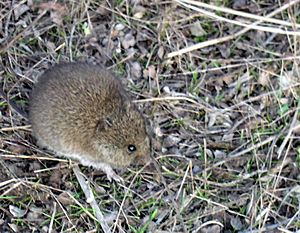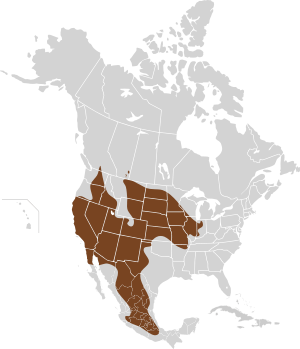Western harvest mouse facts for kids
Quick facts for kids Western harvest mouse |
|
|---|---|
 |
|
| Conservation status | |
| Scientific classification | |
| Genus: |
Reithrodontomys
|
| Species: |
megalotis
|
 |
|
The western harvest mouse (Reithrodontomys megalotis) is a small mouse found across much of the western United States. Some scientists used to think the endangered salt marsh harvest mouse was a type of western harvest mouse. However, most now consider them to be different species.
Contents
Where Western Harvest Mice Live
These mice live in a wide area. Their home stretches from southwest British Columbia and southeast Alberta in Canada. It goes all the way down to west Texas, northeast Arkansas, northwest Indiana, and southwest Wisconsin in the U.S. They also live in the middle of Mexico, reaching as far south as Oaxaca.
What Western Harvest Mice Look Like
The western harvest mouse has brownish fur. Its sides are a light tan color, and its belly is white. It also has a faint white stripe along its back.
Adult mice are usually about 11 to 17 centimeters (4 to 7 inches) long. Their tails are about 5 to 10 centimeters (2 to 4 inches) long. From the ground to the top of their back, they stand about 1.5 to 2.0 centimeters (0.6 to 0.8 inches) tall. A grown mouse weighs between 9 and 22 grams (0.3 to 0.8 ounces). Male and female mice look very similar.
How to Tell Them Apart From Other Mice
It can be tricky to tell western harvest mice from other similar mice.
- The plains harvest mouse has a clearer, but thinner, stripe on its back.
- The fulvous harvest mouse has a longer tail.
- The salt marsh harvest mouse has fur on its belly that is more pinkish-brown.
- The house mouse has smooth front teeth (incisors). Western harvest mice have small grooves on their front teeth.
Western Harvest Mouse Behavior
The western harvest mouse is a nocturnal animal. This means it is most active at night. They are especially busy on very dark nights. These mice are clever and often use paths made by other small animals on the ground. They are also very good at climbing.
When it gets cold, western harvest mice can go into a state called torpor. This is like a deep sleep where their body slows down. Scientists are still studying if they truly hibernate, which is a longer, deeper sleep.
These mice build round nests that are about 12.5 centimeters (5 inches) across. They can build these nests on the ground or under trees, logs, or plants. This helps keep them safe from animals that might hunt them. Nests can also be found above ground in plants or even in burrows. Most nests have one or more ways to get in at the bottom.
What Western Harvest Mice Eat
The western harvest mouse is an herbivore. This means it mainly eats plants. Their diet mostly includes seeds and grains from different plants. Some of these plants are fruits, vetch, blue grass, fescue, oats, and brome grass.
To get ready for autumn and winter, these mice store food. They hide it along the paths they use in fields and in underground storage spots. While seeds are their main food, in springtime they also eat new plant growth. In the summer months (June, July, and August), they are known to eat some insects, especially grasshoppers and caterpillars.
Western Harvest Mouse Reproduction and Life Cycle
Breeding nests are round and made from woven grass or other plant materials. A nest is about 13 centimeters (5 inches) wide and has a soft lining inside. There might be one or more entrances near the bottom of the nest. Most often, the nest is built on the ground in a safe place, like inside a bush or next to a fallen tree. Sometimes, the mouse will build the nest above ground in a bush.
Western harvest mice breed from early spring until late autumn. They are less active in the middle of summer. A mother mouse carries her babies for about 23 to 24 days before they are born. Often, a female can get pregnant again right after giving birth. It's common for a female to have 10 to 14 litters of babies in a year. Each litter usually has 2 to 6 babies, but sometimes there can be up to 9. This means one female can have 40 to 60 babies in a year! Newborn mice are very tiny, weighing about 1.0 to 1.5 grams (0.03 to 0.05 ounces).
Threats to Western Harvest Mice
Domestic cats and wild cats are a danger to western harvest mice. On the IUCN Red List, which tracks how endangered animals are, the western harvest mouse is listed as "Least Concern" (LC). This means it is not currently at high risk of disappearing.
Many animals hunt western harvest mice. These predators include foxes, weasels, coyotes, hawks, snakes, and owls. Other animals that hunt them are shrikes, squirrels, raptors (birds of prey), short-tailed shrews, and scorpions.
See also
 In Spanish: Ratón Cosechero Común para niños
In Spanish: Ratón Cosechero Común para niños


